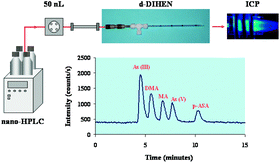Nano-HPLC-inductively coupled plasma mass spectrometry for arsenic speciation†
Abstract
A nano-high performance liquid chromatography-inductively coupled plasma mass spectrometry (nano-HPLC-ICPMS) method is developed, using a demountable direct injection high efficiency nebulizer (d-DIHEN), to reduce sample and mobile phase consumption, minimize organic waste generation, decrease analysis time, and enhance separation efficiency. A HPLC column (50 mm × 0.3 mm id), packed with 3.5 μm C18 material, is explored for chromatographic separation of five arsenic species naturally present in the environment or introduced as a pollutant: sodium (meta)arsenite [As(III)], arsenic acid [As(V)], dimethylarsenic acid (DMA), disodium methylarsenate (MA), and p-arsanilic acid (p-ASA). A fast chromatographic separation of five arsenic species is achieved in less than 12 min at a solution flow rate of 0.9 μL min−1 using a 50 nL sample injection. The HPLC-ICPMS interface provides well defined flow injection profiles at various concentrations, giving a correlation coefficient of 0.999 for each individual arsenic species calibration curve. Precision values for peak height and area of five arsenic species range from 0.5 to 6.5% RSD and absolute detection limits are within 0.4 to 5.4 pg arsenic, which are comparable to previously reported data at higher solution uptake rates (20 μL min−1 to 1 mL min−1) and larger sample injection volumes (20–100 μL).

- This article is part of the themed collection: 2007 European Winter Conference on Plasma Spectrochemistry, Taormina, Italy

 Please wait while we load your content...
Please wait while we load your content...